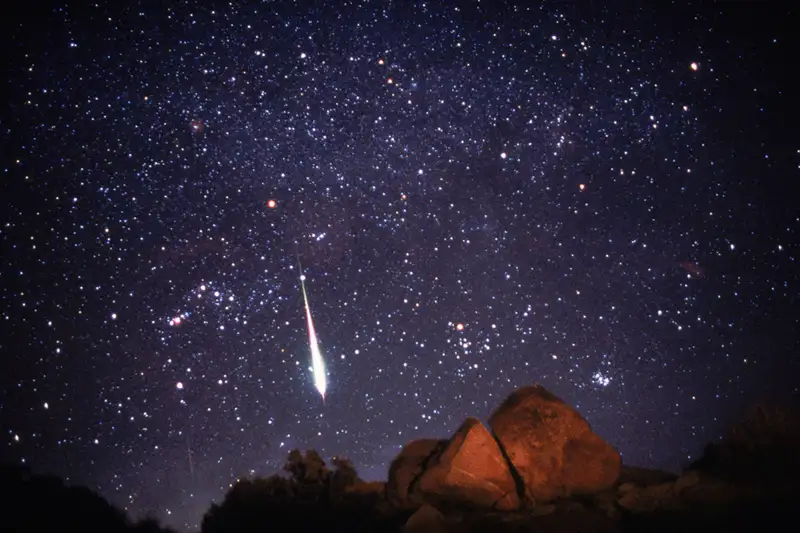The annual meteor shower known as the Leonids, perhaps the most famous of its kind, is about to reach its peak on Saturday morning, November 18. Renowned for its spectacular meteor displays throughout the history of astronomy, the Leonid meteor shower has witnessed extraordinary events, including meteor storms in 1799, 1833, and 1966, where rates reached tens of thousands per hour. In more recent occurrences, like those in 1999, 2001, and 2002, the displays featured a still impressive but slightly more subdued few thousand meteors per hour.

However, it’s essential to clarify that the impression created by the impressive turn-of-the-century Leonid showers may have led some to expect similarly awe-inspiring celestial events every year. It’s crucial to emphasize from the outset that any anticipation of a spectacular Leonid meteor display this year is, to say the least, overly optimistic.
Regrettably, for those expecting a remarkable meteor shower on early Saturday morning, it’s necessary to convey that the 2023 edition of the Leonids is likely to be a disappointment. The display is expected to be weak, with long stretches where not a single meteor will likely be visible.
How to see the Leonids this year
The International Meteor Organization (IMO) predicts hourly rates of 10 to 15 meteors per hour, reaching a peak around 5:00 UT on November 18. The moon, in its waxing crescent phase, will set before 8:30 p.m. on Friday evening, causing no interference. Regardless of the forecast you choose to rely on, it’s important to note that even under optimal conditions, Leonids are expected to cross your line of sight on average once every 3 to 6 minutes. This assumes you have an unobstructed view of the entire sky and are fortunate enough to be in dark, non-light-polluted conditions.

Observing a meteor shower is a relatively straightforward activity: simply lie back, gaze at the sky, and wait. Be aware that local light pollution or obstacles such as tall trees and buildings can further diminish your chances of spotting meteors.
Leo becomes fully visible only after midnight, making it the best time to focus on searching for Leonids. By around 5 a.m. local time, as dawn approaches, The Sickle will have climbed more than two-thirds of the way up from the southeast horizon to the zenith directly overhead.
Additionally, because the Leonids move in their orbit around the sun in the opposite direction to Earth, they collide with our atmosphere nearly head-on, resulting in the fastest meteor velocities possible: 45 miles (72 km) per second. Such speeds tend to produce bright meteors that leave long-lasting streaks or vapor trains in their wake.
While a powerful Leonid fireball can be quite spectacular, exceptionally bright meteors are likely to be very few and far between this year, if any are seen at all.
Comet crumbs
The name “Leonids” is derived from the fact that the shower’s apparent point of origin, where the meteors appear to spread out, is situated within the constellation Leo, the Lion, specifically within the distinctive backward question mark pattern of stars known as “The Sickle.”
These meteors result from the periodic orbit of Comet Tempel-Tuttle, which completes a journey through the inner solar system approximately every 33.3 years. During each closest approach to the sun, the comet leaves behind a trail of dense debris known as a “river of rubble.” The potential for a meteor storm arises when Earth intersects with a recently formed dust trail ejected by the comet within the past couple of centuries.
The majority of comet dust, humorously referred to as the “lion’s share,” can be found just ahead and behind Tempel-Tuttle. The comet’s last traversal through the inner solar system occurred in 1998, leading to remarkable meteor showers in 1999, 2001, and 2002, with diminishing occurrences in the subsequent years.
In 2016, Tempel-Tuttle reached aphelion, the point in its orbit farthest from the sun, at a distance of 1.84 billion miles (2.96 billion km). Currently, the comet is in the process of returning toward the sun and the inner solar system, with its next closest approach to the sun expected in May 2031.

A meager year in 2023
Yet, within the comet’s general vicinity is also where the highest concentrations of meteoroids are found. In contrast, during our passage by the comet’s orbit on Saturday morning, there exists only a scattering of particles—fragments of comet debris that likely broke away from the frozen nucleus centuries, if not millennia, ago.
Therefore, the anticipated activity for the 2023 Leonids suggests a subdued display this year. According to esteemed Russian meteor shower expert Mikhail Maslov, forecasts point to a “moderate” maximum, holding steady at approximately 15 meteors per hour from 0:00 to 12:00 UT on November 18.
Canadian meteor forecasters Margaret Campbell-Brown and Peter Brown, as mentioned in the 2023 Observer’s Handbook of the Royal Astronomical Society of Canada, offer a slightly more optimistic outlook, suggesting rates of up to 20 meteors per hour with a peak expected at 0600 UTC on November 18, corresponding to midnight in eastern and central North America.
Looking ahead, the positive news is that as Comet Tempel-Tuttle approaches the sun, the Leonids are expected to gradually improve. According to Mikhail Maslov, there is a possibility of a greater number of bright meteors, especially in 2025. However, the peak of the next Leonid cycle is anticipated in 2033, with both Maslov and another well-known forecaster, Frenchman Jeremie Vaubaillion, predicting hourly rates of several hundred or more.
The most promising years of the upcoming Leonid cycle are projected to be in 2034 and 2035. In 2034, debris shed by Tempel-Tuttle in 1699 could lead to anywhere from 400 to 1600 Leonids per hour, followed by another surge from material shed in 1767, where 250 to 1000 Leonids are possible. Finally, in 2035, 300 to 900 Leonids are expected from a dusty meteoroid trail dating back to 1633.
For those eager to witness a spectacular meteor shower sooner, there’s good news: The December Geminids, considered the best meteor shower of the year, are coming in less than a month. Expected to produce over 100 meteors per hour, they are set to peak on Wednesday night, December 13. Stay tuned to Space.com for all the details as the date approaches. If you’re interested in observing stars or planets during the new moon or any other time, our guides to the best telescopes and binoculars are excellent starting points.





